
LAKE COUNTY RAILROAD
Even in the dryness of summer, the shoreline remains green. Pelicans, geese,ducks, hawks, eagles, snipe, grebe, rail and a host of other birds abound.
The northernmost section of the old Nevada-California-Oregon narrow gauge line between Lakeview, Oregon and Alturas, Ca.
A serene lake, volcanic mountains, lush, green meadowlands, and wild life in abundance, truly a photographers paradise and a railbikers dream. This sums up the Lake Country Railroad.

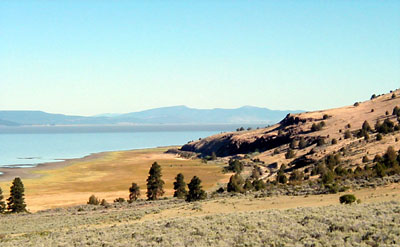
Above, a southbound train
startles a flock of Great White Pelicans from a trackside pond.
Right, the railroad can be seen below as it winds its way along the lakeshore. The drought in the northwest is the worst in
60 years, and the lake,
extremely shallow throughout, has receeded far from its
normal shoreline.
by Peter
narrow gauge railway The Lake County Railroad is the northermost section of the original N-C-O. I won't go into the railroad's background again here, and for any of you who missed that story you can read the history of the railroad by going to the home page and under "Previous Articles" click on the "Modoc Line".
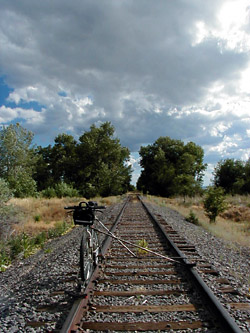
you never can be sure. About 15 miles South of Lakeview there is a great campground at Goose Lake State Park in Oregon. It is right on the California-Oregon border and the railroad runs through the day use area, about 100 yards from the campsites. Arriving in my motorhome with railbike on the back, I was one of only three campers in the entire 30-site park.
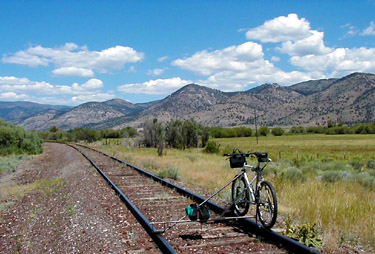
This is the extent of the Lake County Railroad shops and equipment. This engin shed, and the beautiful old origianal N-C-O passenger station ( now privately owned) are located in Lakeview.
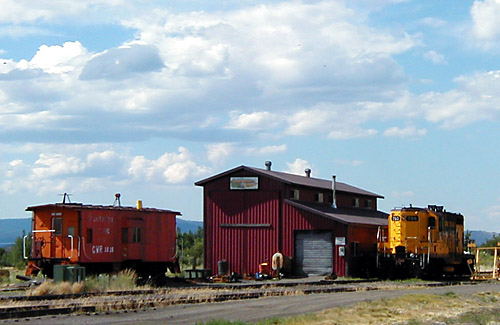
Thunder showers cooled the air on my evening ride north of Goose Lake State Park, Oregon.
A profusion of wild flowers in yellows and blues bordered the track for
miles. Freshly baled hay stands in the field of a neatly kept farm.
Marine battery (lower right behing board) and white coil (front right on the ground) provided the electrical kick for the wires stretched across this cattleguard.
Herds of Mule Deer and Pronghorn Antelope grazed in the fields along the track. Here a young doe pauses before crossing in front of me.
The tracks are far removed from the highway and the only roads encountered were at a few isolated farms. I saw only two fieldhands the entire day and both waved a friendly greeting.
On several long stretches the tracks stretched to infinity, but the miles passed swiftly as there was so much to see. The lake is to the left, and hundreds of cattle grazed along the shores.
Mountain vistas, grassy meadows, a surrounding of peace and tranquility. Oh, that special joy of being completely alone!

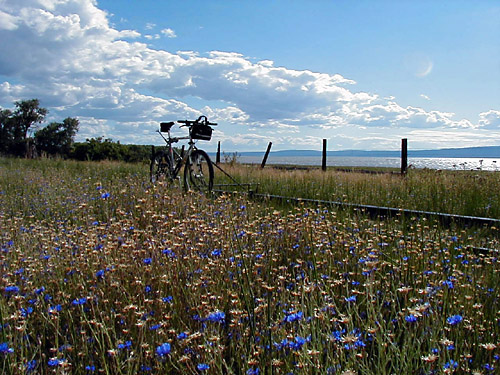
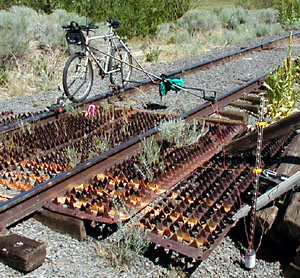

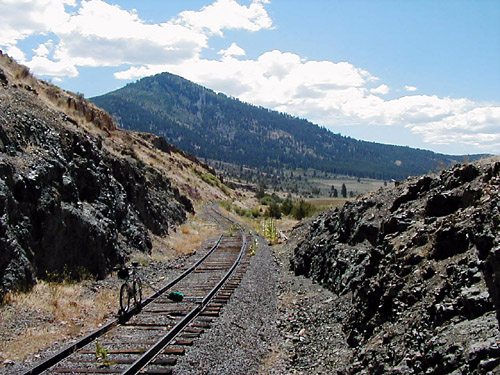
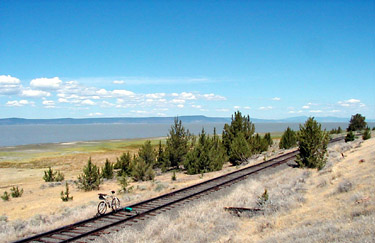
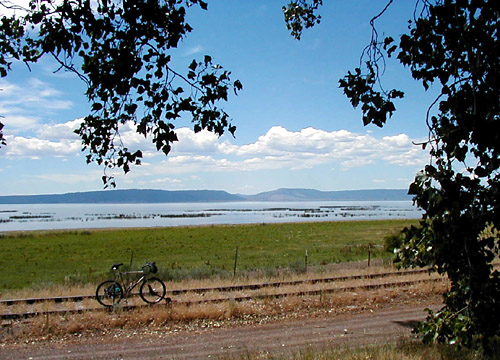
Small stands of Junipers
provided welcome relief
where little vegetation grows,
offereing some precious shade
for my lunch stop.
Along the southern end of the lake
the railroad skirts the base of the
mountains, slicing throught the rocky
volcanic earth.
Sunday I planned to ride south towards
Use your browser's back button to return to the Home Page.
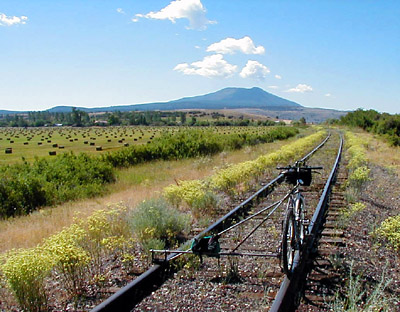
In the July Insider I recounted a ride on the Modoc Line, originally the old Nevada-California-Oregon
But you can't escape without a little history of Goose
Lake, brief as it may be. According to an old Indian who was in his nineties when he was interviewed in 1926, before the day of the white man there was no lake at all. In the center of the valley was a small swamp in which tulles grew. As near as could be learned from the Indian, the lake filled in the 1860's after a rainy summer and an unusually heavy winter. Evidently the lake has evaporated on many occasions since then, leaving only vast plains of snow-white sands.
During the 1830s and 40s, immigrants traveling west
crossed the alkaline valley, leaving wagon tracks that reappeared in 1926 when the lake was dry. In that year great dust storms swept across the valley and filled the air with choking alkali dust as far as fifty miles to the north. But the following year the lake filled again. Most recently the lake disappeared in 1993. If the current drought cycle continues, it may be gone again in 2002 Goose Lake has 84 miles of shoreline when full and a maximum width of 10 miles. Average depth is only 8 feet!
I planned my ride for Saturday and Sunday, as trains
are scheduled for Mondays and Fridays and an occassional Wednesday if business is good. I reasoned no maintenance would be done over the weekend, but
Alturas, along the lake and past the volcanic hills which rise above it, a round trip of about 35 miles. Saturday evening I rode north, in the direction of Lakeview, a shorter ride of perhaps 6 miles out and back. Beyond that point the railroad runs within sight of Highway 395. The weather ws perfect, about 75 degrees, with great thundershowers sweeping across the broad expanse of lake. There is something about electrical storms that add a special excitement to any adventure, and the ominously dark clouds, the rolling thunder and gusting winds were the perfect prelude for my railbike weekend.
Early the next morning I was up and on
my way. The clouds were gone, the air fresh and the sky a deep cobalt blue. I rode from my campsite to just south of the day use area where the road crosses the tracks and set up the railbike. I feared being seen by some fishermen out early, but not a soul was about. Immediately I was riding through a wild-fowl wonderland. Great flocks of Pelicans were feeding in the grassy shallows along the lakeshore. Hundreds of Canadian Geese would honk in alarm at my approach. Hawks glided close overhead and Grouse scampered across the tracks in front of me.
In the first eight miles I passed several
farms and rode in the shade of grand old trees. Wildflowers in great patches of blues and yellows were everywhere, sometimes bordering the tracks for miles. Grass and weeds were heavy despite the passing of trains but were not a hinderance. Oddly, the roadbed would
lean severely to one side and then the other on the straight stretches, and I was constantly adjusting my camber to maintain my balance. I can't imagine what it feels like in the cab of a locomotive.
After the first eight miles the
railroad left the trees and ran across wide-open fields. Here there are several long sections of track stretched into infinity. But monotomy was not a problem and the miles rolled by swiftly. Large herds of cattle grazed along the grassy lakeside. Startled by my passing, several hundred stampeded. I felt guilty for running this well-fed beef for miles thinking how many pounds of profit were burned up in this episode. On the opposite side of the track a small band of Mule Deer bounded along with me for perhaps ten minutes, stopping often to see if I was still in pursuit.
My interim goal was the
Wilson Ranch, a historic spread dating back into the mid 1800s. Once past the ranch the rails begin to wind and twist around the volcanic hills that come down to the lakeshore. The terrain changes abruptly and the roadbed rises slightly as it passes through the rocky countryside. The rails are better maintained in this section and riding was much easier. Quite often I would pass over metal cattle guards with wicked metal teeth. But nothing prepared me for the surprise when I encountered an electic fence stretched across one of them. A large marine battery supplied the power with a coil to give the wires the necessary jolt.
Can you imagine the train crew having to stop here on the way out and on the way back to disconnect and reconnect the wires every time they pass? This truly is shortline railroading!
Just past this cattle guard I startled a
herd of Pronghorn Antelope who raced at great speed along the lakeshore below me, their telltail white behinds bouncing to and fro. They ran for miles, scattering cattle and raising a ruckus among the geese. In this
section cattle high on the rocky banks above the track can be a serious hazard. When spooked, they can dislodge large rocks which can come crashing down on the roadbed. My first ride on this line was with a speeder group and a large dislodged boulder hit the car directly behind us. It tore off the windshield and only missed the two occuupants by inches. I kept my eyes open for similar trouble.
Reaching the end of the hilly section it
was time to turn and head home. Further ahead the rails cross a large flat plain and then run through a small canyon and along a stream as they approach Alturas. Too far for me to ride out and back in one day, and the final miles into Alturas are close by the highway and not prudently ridden.
The temperature was now about 85
degrees, cool for this time of year but hot enough to seek some shade for lunch. Small stands of Pinion Pines dotted the landscape and I found some welcome shade. The return trip was just as enjoyable as the ride out, except for climbing over the electric fence with my bike on my shoulder and those sharp iron cattle guard teeth penatrating the soles of my shoes.
Back at the camp grounds a man with a video camera filmed my approach. He had never
seen a railbike and was absolutely fascinated. He filmed the entire breakdown of the bike and then me as I rode away on the path back to my motorhome. Without that evidence I'm sure his wife would never believe him.
Although not as spectacular as Camas Prairie or Carriso Gorge, the Lake County Railroad is
unique unto itself. At almost 5000 feet elevation the air is clear and invigorating. The scenery is varied and beautiful. The lake is a jewel in the middle of the high desert. And the abundance of
God's creatures a joy to behold. I rank this ride as one of my favorites.